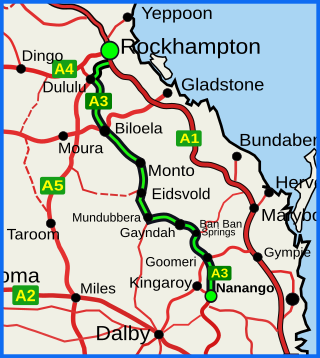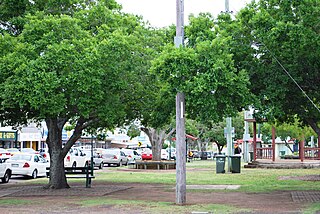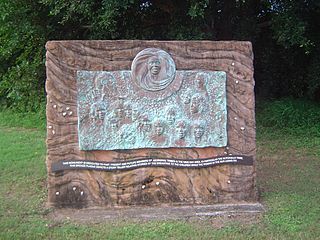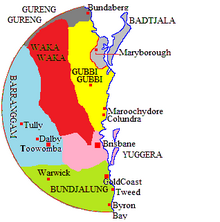
The Burnett River is a river in the Wide Bay–Burnett and Central Queensland regions of Queensland, Australia.
The Goreng Goreng, also known Kooreng Gooreng, are an inland Freshwater Australian Aboriginal people of Queensland, and also a language group. The Goreng Goreng area is between Central West Queensland in the north around Boyne Valley, extending westerly as far as the Great Dividing Range along the Dawes, Auburn, Nogo and Callide Ranges to meet the Wulli Wulli and Ghunghulu to their immediate west over the Great Dividing Range.

The Burnett Highway is an inland rural highway located in Queensland, Australia. The highway runs from its junction with the Bruce Highway at Gracemere, just south of Rockhampton, to the D'Aguilar Highway in Nanango. Its length is approximately 542 kilometres. The highway takes its name from the Burnett River, which it crosses in Gayndah. The Burnett Highway provides the most direct link between the northern end of the New England Highway and Rockhampton. It is designated as a State Strategic Road by the Queensland Government.

Eidsvold is a rural town and locality in the North Burnett Region, Queensland, Australia. The town is the self-proclaimed Beef Capital of the Burnett and is a hub for the regional cattle industry. In the 2016 census, the locality of Eidsvold had a population of 574 people.

The Gubbi Gubbi people also known as Kabi Kabi are an Aboriginal Australian people native to south-eastern Queensland. They are now classified as one of several Murri language groups in Queensland.

Murgon is a rural town and locality in the South Burnett Region, Queensland, Australia. In the 2016 census, the locality of Murgon had a population of 2,378 people.

Ban Ban Springs is a locality in the North Burnett Region, Queensland, Australia. In the 2016 census, Ban Ban Springs had a population of 7 people.

Cherbourg, formerly known as Barambah, Barambah Aboriginal Settlement and Cherbourg Aboriginal Settlement, is a rural town and locality in the Aboriginal Shire of Cherbourg, Queensland, Australia.

The Shire of Kingaroy was a local government area in the South Burnett area of Queensland, Australia, about 100 kilometres (62 mi) northwest of the capital, Brisbane. The shire covered an area of 2,420.3 square kilometres (934.5 sq mi), and existed as a local government area from 1912 until 2008, when it amalgamated with a number of other local government areas in the South Burnett area to become the South Burnett Region.

The Shire of Murgon was a local government area in the South Burnett region of Queensland, Australia. The shire covered an area of 664.7 square kilometres (256.6 sq mi), and existed as a local government entity from 1914 until 2008, when it amalgamated with several other councils in the South Burnett area to become the South Burnett Regional Council.
The Turrbal are an Aboriginal Australian people from the region of Brisbane, Queensland. The name primarily refers to the dialect they speak, the tribe itself being alternatively called Mianjin/Meanjin/Meeanjin. Mianjin is also the Turrbal word for the central Brisbane area. The traditional homelands of the Turrbal stretch from the North Pine River, south to the Logan River, and inland as far as Moggill, a range which includes the city of Brisbane.
The Aboriginal Shire of Cherbourg is a local government area in Wide Bay–Burnett, Australia. In June 2018, it had an estimated population of 1,315.

The Jagera people, also written Yagarr, Yaggera, Yuggera, and other variants, are the Australian First Nations people who speak the Yuggera language. The Yuggera language which encompasses a number of dialects was spoken by the traditional owners of the territories from Moreton Bay to the base of the Toowoomba ranges including the city of Brisbane.

Wide Bay–Burnett is a region of the Australian state of Queensland, located between 170–400 km (110–250 mi) north of the state capital, Brisbane. The area's population growth has exceeded the state average over the past 20 years, and it is forecast to grow to more than 430,000 by 2031. It is the subject of the Draft Wide Bay–Burnett Regional Plan, which aims to facilitate this growth while protecting over 90% of the region from urban development.

The Wakka Wakka language, also spelt Waga, or Wakawaka, is an extinct Pama–Nyungan language formerly spoken by the Wakka Wakka people, an Aboriginal Australian nation near Brisbane, Australia.
Wuliwuli is an extinct Australian Aboriginal language of the Pama–Nyungan language family formerly spoken by the Wulli Wulli people in Queensland, Australia. The Wulli Wulli language region includes the landscape within the local government boundaries of the North Burnett Regional Council, particularly the town of Eidsvold and the Auburn River catchment, including the properties of Walloon, Camboon, and Hawkwood. Wuliwuli is regarded as a dialect of Wakka Wakka.
The Dalla, also known as Jinibara, are an indigenous Australian people of southern Queensland whose tribal lands lay close to Brisbane.

The Butchulla, also written Butchella, Badjala, Badjula, Badjela, Bajellah, Badtjala and Budjilla, are an Aboriginal Australian people of K'gari, Queensland, and a small area of the nearby mainland of southern Queensland.
The Goeng or Gureng were an Aboriginal Australian people of the state of Queensland. They lived in the area of the area of present-day Gladstone.
The Jarowair are an indigenous Australian people of the Darling Downs area of Queensland.













